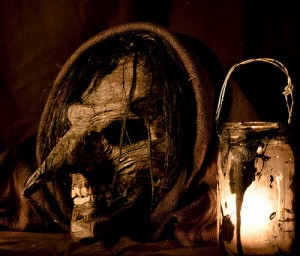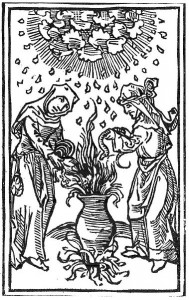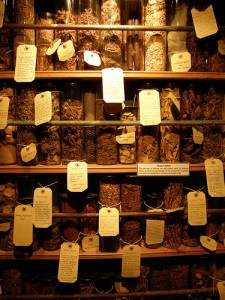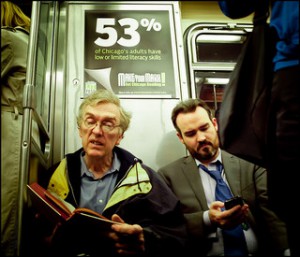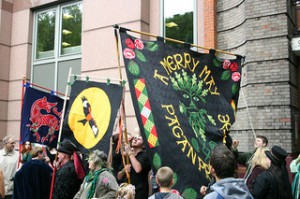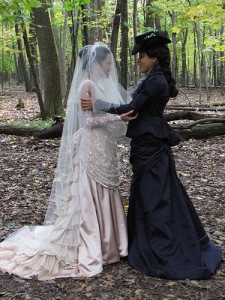It seems that during the last year, there has been an increase on the interest regarding social topics for the pagan community – whether related to the need for celebrants or (more concretely in Holland) with projects like an elderly house for pagans, proper venues for rituals or pagan services in general. From inside this and many similar discussions, the question arises: Whether we, as witches, have a social role in the modern society.
Archetype, myth and history
The character of the witch has become an archetype in our modern society – drawing inspiration from folklore, tales and stories featuring country witches, shamans or völvas. As result we encounter a peculiar personage (often a woman, depicted as an old hag) that bears supernatural powers, casts spells and dwells deep in the forest, or in the outskirts of the village. This has become the reference model of the witch featured in modern films, TV series; even though there has been a late intention of portraying witches as average good-willed citizens.
Nevertheless, even when those witches have been represented as ill-willed individuals doing curses and binding love spells, they have always been placed in a neutral context, that of the community service. That is, there was no agenda behind the magical work, just work. We would all probably remember the scene in ‘Practical Magic’ where the aunts of the little witches are offering a love/binding spell to a desperate woman – one could assume that they would be more than willing to also offer the counter spell to the victim!
In some way, this reminds me of how fata or faery beings are regarded in some witchcraft circles: mostly being beyond human references of ‘good’ and ‘bad’, working towards their own purposes. It could be more than a coincidence that witches have often been regarded as ‘faeries’, the leader being the ‘Faerie Queen’.
In folklore this is seen on the relationship between the common people and the witch. While the latter is feared, bullied and gossiped about by the first, it is also the figure of relief in moments of need: when the matter is too shameful to be shared with the priest, when the common healing methods do not work anymore, or when the matter simply fall into ‘witches business’. The stories tell us that this work always comes with a price – commonly an overpriced one, taking advantage of the need of the client and the certainty that the individual will not complain about it in fear of the criticism of his neighbours.
The above may not fall into what we’d consider ‘community service’ nowadays, but it was nevertheless a service, and aimed for the local community.
In ‘The Triumph of the Moon’ Prof. Ronald Hutton, inspired by the work of Prof. Owen Davies, writes about practitioners of operative magic in England & Wales between 1740 and 1940. In this chapter he covers the different kinds of witches, cunning man, charmers, astrologers, both from the countryside and the city. He says:
‘Charmers usually regarded their healing power as a gift, to be used for the good of humanity, and therefore thought it wrong to demand payment; but there were two qualifications to this rule. One is that it was not observed by all […] The other is that patients usually gave a present to the healer by way of gratitude.’
He also mentions other groups of cunning-folk who would rather charge a fixed fee, a high one when it involved wealthy clients.
Even though this is a contextual affirmation (both by location and time), we can recognise a role for our archetype of a witch in it.
In Doreen Valiente’s early book Where Witchcraft Lives she writes:
‘In any case, the patient had to come to the charmed in complete trust and confidence of a cure. The charmer must be neither thanked nor paid, though they could be given a present after the charm had worked.’
Both quotes by Hutton and Valiente suggest that there was a close relationship of co-dependence between the witch and the local community: the witch would be sometimes sustained by the gifts of her clients, as Hutton suggests, and the community would have someone to reach to in moments of despair.
Whether the witch actually depended on the community or this was an isolated phenomenon, what it is clear is that the witch (or cunning-man, shaman, healer) had a role in the community – or very close to it.
Modern Witchcraft
After last century’s witchcraft revival, however, the archetype of the witch has slightly changed – if not for the general society, certainly for us witches. From one of the works of the precursor of this revival we read:
These Wica generally work for good purposes and help those in trouble to the best of their ability.’
(Witchcraft Today, Gerald B. Gardner. Citadel Press)
The witch seems to be no more in a ‘grey field’ between ‘good’ and ‘bad’, but working positive magic. Throughout the book, Gardner presents other arguments against the ‘negative’ use of witchcraft by witches (like the wax doll example).
Many modern witches argue that such a statement is not completely accurate, and that modern witches still know how to curse and bind. Nevertheless, for the purpose of this article, what matters is that Gardner still regarded the witches, or The Wica, as having a role within the general community.
Nowadays, asking for a high fee could be as well regarded as a ‘fraud’ in some circles. But some witches work professionally as tarot readers and astrologers, and thus the line is slightly blurred. This should be judged in a case-to-case basis.
Then again, society has radically changed during the last centuries, and while it was quite common for people to know each other in small villages or neighbourhoods, big cities with apartment blocks may not be the most suitable scenario to develop such a relationship with our surrounding community.
Moreover, the popularity of Internet has led to a slight decrease on face-to-face contact. We can now chat, skype, tweet, or instagram what we are doing. On the positive note, however, we can be in touch with people in the other side of the globe instantly.
In such a modern context, witches have tried to encourage the re-connection with the earth and its cycles, with the people, with our own selves. And it seems that the community is also eager of a more human contact (pub moots, open rituals).
One could ask: What does helping the community as a witch? Does it mean I have to help every Tom, Dick and Harry? Most certainly not. And let us be honest, not all of us have natural healing skills – and anyway, we have an amazing thing called universal health system in most of the countries.
But modern times bring modern ailments, and sometimes people just need someone to speak to, some wise counselling, a tarot reading to put things into perspective, or a bit of simple magic. That we can do, very well indeed.
Going pagan and identity
In addition to the above, I would like to take the questions further on: Do we as witches have an aiding role in the pagan community and general society?
Now, many witches or wiccans do not consider themselves pagans. They may be actively working with what we call the ‘pagan community’, have friends there, hang with them, but they do not like the term, neither do they think they have a duty or responsibility towards it.
This is, of course, a very respectable position – and this article is not intended to focus on the use of terms and tags, but rather on the involvement of witches in the different layers of the community.
The most popular arguments that I have found can be simplified in two – the first being not wanting to be related to the general pagan community or modern forms of wicca (which can be linked to the non-identification with the term Pagan, mentioned above). Once again this is easily understandable. The second makes reference to our oath as witches, stating that we are just obliged to help our Brothers and Sisters of the Craft.
This last statement implies a sense of obligatory nature in this ‘service’, but also that our abilities should just be used in aid of other witches (and most probably only those initiated, leaving hedgewitches outside the scope).
While I have always thought that witchcraft has a great deal of inner work and ‘self-healing’ or ‘self-development’ either through its shamanistic or ritual practices, one could say that witchcraft also has a great deal of the cunning-folk, sometimes called ‘low magic’. Witches may be versed in healing, divining, casting, knotting, weaving, chanting, and a myriad of other methods. And all that may seem too much just to help other witches.
Going social and relevancy
And finally, the initial question: Do we, as witches, have a social role in the modern society?
Magic is not the only think that we witches can work. And I believe that we like to see ourselves as advocates of freedom, rights and freethinking – many times as pioneers.
Internet has become an incredibly helpful tool in that sense, allowing us to be aware of global campaigns and participating in them – either via donations, signatures, or just spreading the word.
However, it also seems that there is a conditional sense here; some topics are considered more politically correct and pagan related, while others aren’t. On the first group we would have environmental work (and everything ‘green’), women rights and general natural disasters (we love lighting candles!), while the former includes topics as homophobia, immigration, many other humans and sometimes, believe or not, even interfaith (many witches are not very fond of it!).
Addressing topics in the latter group may face a questioning about the relevance of such a topic for witches, or pagans.
Final thoughts
When coming to the Craft, we are initiated both as Witches and Priestesses/Priests. Personally, and even though we could endlessly talk about that double denomination and the myriad of possible meaning, this makes reference to two different (but interwoven) roles.
It is also said that as priestesses/priests, we are ‘the hands and feet of the gods on earth’, not in an authoritative sense, but rather in that of the service – a service to the community.
In a recent interview to Maxine Sanders by Karagan Griffith for the G+ group ‘Wicca Tradicional’ she was asked “What do you think should be the role of the priesthood of witchcraft in the community at large outside of the temple?” To that she answered:
As a priestess of the Craft my door is always open, my job as a priestess is to serve the community in any way that I can… as a good member of that community… not because I want to be recognized as a witch for doing it […] Perhaps, as a witch, people would knock my door they’d want perhaps herbal concoction or they would want counselling in a way only the witch can’.
Needless to say, we all have different concerns, and we definitely cannot cope with everything. Some may prefer to get involved with Greenpeace and shelter for animals, while others may get more involved in pagan organisations – and some may just prefer to be outside of the scene, but only purchase local products, therefore actively (and silently) campaigning.
In one way or another, I want to believe that we, as witches, do have a role in today’s modern society. It may not be the most prominent or influential one, but it is what we do best, and what we enjoy doing. And many would say it’s worth it!

